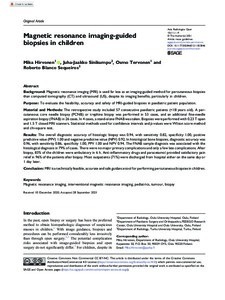Magnetic resonance imaging-guided biopsies in children
Hirvonen Mika; Sinikumpu Juha-Jaakko; Tervonen Osmo; Blanco Sequeiros Roberto
https://urn.fi/URN:NBN:fi-fe2022012710615
Tiivistelmä
Background: Magnetic resonance imaging (MRI) is used far less as an imaging-guided method for percutaneous biopsies than computed tomography (CT) and ultrasound (US), despite its imaging benefits, particularly in children.
Purpose: To evaluate the feasibility, accuracy and safety of MRI-guided biopsies in paediatric patient population.
Material and Methods: The retrospective study included 57 consecutive paediatric patients (<18 years old). A percutaneous core needle biopsy (PCNB) or trephine biopsy was performed in 53 cases, and an additional fine-needle aspiration biopsy (FNAB) in 26 cases. In 4 cases, a stand-alone FNAB was taken. Biopsies were performed with 0.23 T open and 1.5 T closed MRI scanners. Statistical methods used for confidence intervals and p-values were Wilson score method and chi-square test.
Results: The overall diagnostic accuracy of histologic biopsy was 0.94, with sensitivity 0.82, specificity 1.00, positive predictive value (PPV) 1.00 and negative predictive value (NPV) 0.92. In histological bone biopsies, diagnostic accuracy was 0.96, with sensitivity 0.86, specificity 1.00, PPV 1.00 and NPV 0.94. The FNAB sample diagnosis was associated with the histological diagnosis in 79% of cases. There were no major primary complications and only a few late complications. After biopsy, 83% of the children were ambulatory in 6 h. Anti-inflammatory drugs and paracetamol provided satisfactory pain relief in 96% of the patients after biopsy. Most outpatients (71%) were discharged from hospital either on the same day or 1 day later.
Conclusion: MRI is a technically feasible, accurate and safe guidance tool for performing percutaneous biopsies in children.
Kokoelmat
- Rinnakkaistallenteet [27094]
